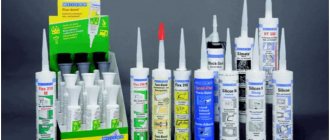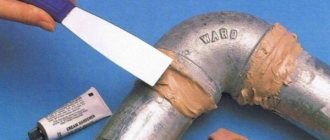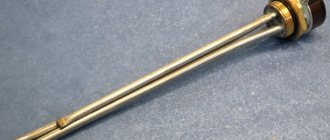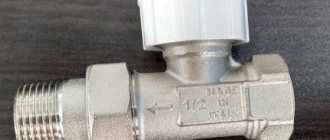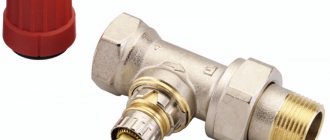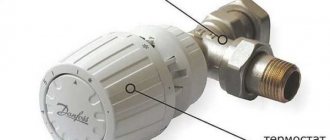Any homeowner doesn't want to have to replace their entire heating system because of a couple of leaks. Most often, the old circuit is made to last and can last for many years. And the most critical places gave in the slack. Let's figure out how to choose the right sealant for a heating radiator and how to eliminate a leak without completely dismantling the system.
The heating radiator is leaking Source slavasozidatelyam.ru
Types of sealants and requirements for them
Before the advent of special compounds, home craftsmen tried to use various folk remedies to repair leaks in the heating circuit. One of them is regular dry mustard. It was introduced into the water and launched into the system. The powder thoroughly clogged the small hole and the heating pipeline continued its work.
True, not very long. A side effect of such repairs is the inevitable failure of filters, as well as any other equipment. For example, a heating boiler. Therefore, homeowners were incredibly happy when the chemical industry began producing special and safe sealants.
Today, there are several different compositions for repairing heating systems:
- For external use.
- Internal volumetric use.
- For repair and sealing of threaded connections.
Any sealing material must provide complete isolation of water leakage in a short time. This is necessary so that the owner can prepare for a major overhaul of the system without turning off the heating in the house. But most often, most compounds are able to patch a small hole efficiently and for a long time.
Using sealant together with masking tape Source radiator-expert.ru
Requirements for sealants for water heating radiators:
- heat resistance;
- good adhesion;
- fast setting;
- high hardening strength;
- ease of use;
- safe use.
Almost all products produced by the chemical industry meet these parameters. And before choosing the type of sealant, it is necessary to diagnose the degree of damage and accessibility to the repair site. Let's take a closer look at how to properly use each category of adhesives.
Popular brands
The market offers sealing materials for stoves, fireplaces and chimneys. They are selected according to their composition and operating temperature. It is recommended to use products from reputable manufacturers.
Soudal
Soudal (Saudal) is a Belgian company that specializes in the production of sealing compounds. Soudal sealant for stoves and fireplaces is the Soudal series.
Calofer, heat-resistant compounds in black. Materials based on sodium silicate do not emit toxic substances when heated and can be painted. Suitable for sealing cast iron elements of boiler units. One of the advantages of Belgian products is their resistance to cracking and crumbling.
Penosil
An Estonian company produces silicate paste for Penosil +1500 ovens. The material has high heat resistance and is black in color. Foam is cheaper than the products of the famous Belgian manufacturer, but is not inferior in quality. This makes Estonian sealant widely in demand among professionals and home craftsmen. The company's product line also includes the silicone sealing compound Penosil Hight Temp, suitable for use for moving joints due to its elasticity.
Tytan
Under this brand, sealing compounds are produced by the Selena Group, a group of Polish manufacturers of professional materials for construction and finishing. The sealing paste contains fiberglass, which provides the sealed seams with increased gas tightness. The material is designed to be heated to high temperatures (1250 degrees), which makes it suitable for sealing seams and cracks in fireplace and stove masonry, and for installing chimneys. Products of the Tytan brand, as well as sealants with similar properties, which are produced under the Baumaster brand, belong to the middle price category. In terms of price and quality ratio, this is the best option for a wide range of consumers.
Makroflex
A well-known Estonian manufacturer of sealing materials supplies the market with fire-resistant silicate composition Makroflex HA147. It can withstand short-term heating up to a high temperature of +1500 degrees and exposure to an open flame. The advantages of the paste of inorganic materials include adhesion to most materials used in construction and the absence of shrinkage upon drying and under the influence of temperature fluctuations.
Krass
The Russian manufacturer offers the refractory composition “Krass fireplaces and stoves”. Using this material, fireclay masonry and fireproof masonry can be installed in the furnace firebox. The composition can withstand sudden increases in temperature, is not afraid of open fire, and is suitable for repairing brick stoves and fireplaces, as well as heating boilers. This is a non-shrinking material made on the basis of liquid glass. Thanks to its paste-like consistency, it is easy to apply.
For external use
Not every product is suitable for repairing hot water pipelines. Manufacturers produce sealant to eliminate water leaks using three types of main raw materials. Acrylic, silicone and polyurethane are used for it.
The first one is completely unsuitable for a heating system. Acrylic sealant loses its plasticity when it hardens. As a result, temperature deformation can destroy the base. Therefore, this composition is used only for repairing cold water supply.
Sealant for threaded connections Source radaprom.ru
Before purchasing sealant, you must carefully read the labeling on the package. For sealing small holes in a heating radiator, only a heat-resistant compound is suitable. The operating temperature range should also be indicated in the instructions.
Products based on silicone and polyurethane meet these requirements. But the latter glue is mainly used for construction work. Although its properties are quite acceptable for use in a heating circuit. It is quite elastic and has good adhesion. Able to withstand high liquid temperatures and excellent resistance to corrosion processes.
But only some of its brands have such characteristics. Therefore, when choosing, you must read the manufacturer’s recommendations. In addition, most polyurethane compounds are two-component. They are difficult to work with because after mixing with epoxy resin, the glue hardens very quickly and loses its plasticity. And good one-component products are very expensive.
Silicone sealant on a neutral basis Source kronas.com.ua
See also: Catalog of companies that specialize in engineering systems (heating, water supply, sewerage and others) and related work
The best sealant for heating pipes is made from rubber-based silicone. Its characteristics satisfy all requirements. In addition, you can significantly enhance the effect of application if you apply it to a reinforcing mesh. But you also need to be careful with this choice.
The fact is that some silicone sealants contain an acid base. And it is strictly forbidden to use them to repair metal surfaces. When hardened, acetic acid is formed, which will inevitably cause corrosive processes. Therefore, for iron pipes with hot water, you need to choose either alkaline or neutral compounds.
How to use silicone sealant
Experts recommend using serpyanka as a supplement. This masking tape will act as a reinforcing mesh. Such a combination of sealant for the heating system and serpyanka will significantly increase the reliability of the patch and significantly extend its service life.
Masking tape (serpyanka) Source forum-dag.ru
Step-by-step actions when repairing heating pipes:
- The emergency area is dried. Then it is thoroughly cleaned and degreased.
- A layer of sealant is applied to the surface.
- A row of serpyanka is wound on top. In this case, the turns must be placed strictly at the joint.
- Then the sealant is applied again.
- And once again they wind the serpyanka. But the coils are already laid with an overlap of 1 cm.
- It is necessary to make at least four such alternating layers, preventing air from getting inside.
- The last to be wound are 2-3 layers of serpyanka without glue. And they are securely fixed with nylon clamps.
- After the silicone has hardened, the excess turns of the painting mesh with clamps are cut off.
- The final layer of sealant is applied over the resulting structure and smoothed well. It's called "repair".
Work is carried out at an ambient temperature of no less than +5 degrees Celsius. In this case, it is necessary that the silicone itself is heated to +18 °C. The hardening time of the composition depends on its type. But basically the layers harden at a rate of several millimeters per day.
Checking the battery after repair Source jackwharperconstruction.com
How the authorities of Sevastopol created problems for the state port
According to information available to ForPost from its own sources, on the evening of January 17, in the government of Sevastopol, employees of special services were indeed seizing documents in the case of the possible deliberate bankruptcy of the Sevastopol Sea Port. It is for this reason, the source reports, that the regional governor, Dmitry Ovsyannikov, refused to meet with Syrian President Bashar Assad during a trip abroad and flew to Sevastopol.
Let us recall that earlier a number of online sources and alternative media reported about a conflict that flared up within the walls of the city-regional government around the anti-corruption unit, which discovered possible traces of the deliberate bankruptcy of Northern Seaport.
Official sources
At the same time, public sources contain enough information indicating that the government structure of Dmitry Ovsyannikov took steps that likely have a chance of creating great financial difficulties for Sevmorport.
The point is that at the end of 2022, the Department of Property and Land Relations of Sevastopol flooded Sevmorport with lawsuits for debt collection. Let's give a few such examples.
The Sevastopol Arbitration Court made the first decision in favor of the government on October 30, 2022, obliging Sevastopol Sea Port to recover 1 million 750 thousand rubles of debt for renting a land plot (a warehouse located on the 5th km of Balaklava Highway) for the period from September 29, 2017 to 05/31/2018
The second decision to collect 265 thousand rubles of debt in favor of the government for renting a land plot in Kamyshovaya Bay (with berths No. 221, 222, 223, 224, 225, 227, 228, 229, 230) was made by the Arbitration Court on November 13, 2022.
And on November 28, 2022, the Arbitration Court of Sevastopol made a third decision - to recover from Sevmorport 687 thousand rubles of debt for renting a land plot on Rybakov Street, 5.
Unprofitable enterprise
Thus, the state enterprise “Sevastopol Sea Port”, created by the government of Sevastopol itself in June 2014, at the end of 2022 found itself with debts of more than 2.7 million rubles only based on the results of three ships. Add to this the likelihood of other financial problems that we are not yet aware of, as well as the fact that as of the last reporting year, Sevmorport had a negative profit of about 1.94 million rubles, and we get a very unfavorable picture.
Why a state-owned enterprise established by the government of Sevastopol, which includes the entire maritime infrastructure of the region associated with maritime cargo and passenger transportation, found itself in such a situation is a big mystery.
Liquid formulations
It happens that the leak is not visible, but the volume of the coolant liquid gradually decreases. And the pressure generated by the circular pump has dropped. This can happen if there is hidden pipework. For example, they are partially in the walls. Or a heated floor system has been installed.
Dismantling the cladding is a labor-intensive and expensive task. And in this case it is better to use liquid sealant for hidden leaks. It is poured into the heating system and independently seals the hole from the inside. The product is also perfect for batteries. When the leak itself is visible, but it is not possible to apply a clamp or patch to this place.
But you need to use the liquid adhesive without haste. If the pressure in the system has dropped, this does not always indicate a hidden leak. First you need to inspect the expansion tank. Perhaps the membrane in it simply collapsed. That's why the pressure dropped.
Dilution of liquid sealant with coolant Source infourok.ru
There are quite a few types of liquid formulations. And each of them works well only under its own optimal conditions. Sealants are divided mainly by type of coolant (water or antifreeze) and pipeline material (metal or plastic). Therefore, when purchasing, you must carefully look at the labeling and be sure to read the instructions from the manufacturer.
Liquid sealant for the heating system is purchased in a strictly defined quantity. This is due to its operating principle. The particles dissolved in the coolant remain in a neutral state until they come into contact with air. It is in the area of the hole that polymerization begins to occur.
The particles harden and clog the crack from the inside. This is why the concentration of the solution used is so important. And for this it is necessary to calculate the entire volume of the heating circuit. In order to dilute the required amount of the composition in accordance with the instructions.
To determine the total volume, find the necessary data in the technical data sheets of the boiler and radiators. Then measure the length of the pipeline and multiply the resulting value by the diameter of the pipe. All results are summed up. And for those who do not trust calculations, you can drain all the coolant into one container and in this way find out the volume of the system.
Why is tightness needed?
Brick stoves and fireplaces are prone to cracking due to uneven heating of the masonry, especially if it is not protected by a layer of plaster or tiles. If the cracks in the body of the heating unit turn out to be through, this entails unpleasant consequences
:
- fuel is consumed faster because it burns under conditions of additional oxygen;
- soot may enter the room and settle on the walls and ceiling;
- combustion products enter the room, primarily carbon dioxide, which can cause poisoning.
Cracks in a brick chimney, cracks in a metal pipe for removing combustion products reduce draft, and the heating unit cannot operate in optimal mode. This causes the fuel to burn at lower temperatures, producing a lot of ash and more soot deposited on the inside of the chimney.
A large amount of soot and a leaky chimney is a dangerous combination. The intake of air causes the soot to ignite, and it burns at temperatures above 1500°C, causing the chimney to heat up. An insufficiently thick layer of thermal insulation around the pipe will not save wooden structures from charring; there is a serious risk of fire.
For gas boilers, a leak in the chimney results in gusts of wind extinguishing the burner. To avoid the need to regularly check the operation of the boiler, the gaps in the chimney duct are sealed with a special sealant.
Seals
Radiator sealant is also successfully used for all threaded connections. Sometimes it is used instead of (or together with) FUM tape, which has completely replaced flax tow. There are liquid and paste formulations. They can harden completely or remain elastic throughout use.
Among the pastes, the Unipack brand is popular. It does not harden and contains flax fibers. Its main advantage is the ability to protect the joint from corrosion. And if necessary, it can be easily removed.
Anaerobic drying pastes are vibration resistant and can withstand temperatures up to +200 °C. Their only disadvantage is the inability to tighten the threaded connection if necessary. In this case, all tightness is immediately broken. Among the products, the PERMATEX brand is in wide demand.
Usage
External treatment
So, we have become familiar with the types of compositions, now we will look at how to use radiator sealant.
The work is performed in this order:
- If you need to fix a leak, you should first find the damaged area.
- Then you need to drain the coolant from the radiator.
- Next, you need to clean the damaged area with your own hands from dust, dirt, old paintwork, etc.
- After this, the composition is applied to the treated area.
- Then you need to wait for the sealant to dry, after which you can fill the system.
Internal processing
Now let's look at how polymerizing sealant is used for radiators.
This process is not much more complicated than external processing:
- Before pouring sealant into the radiator, it is advisable to rinse it with running water.
- Next, you need to dismantle all filters or cut them off with taps.
- Then you need to start the system and heat it to 50-60 degrees.
- After this, it is necessary to bleed the air from the system, otherwise it will begin to interact with the product.
- Next, you need to drain the water from the system and use it to prepare the solution. In this case, a couple of liters should be left for flushing the pump.
- Then you need to remove the Mayevsky tap from the battery and connect a “Malysh” type pump instead.
- Using a pump, a solution of sealant and water is introduced into the system. If the volume of coolant in the system does not exceed 80 liters, one liter of product is sufficient. Otherwise, its quantity needs to be increased.
- Next, you need to raise the pressure in the system to 1.5 atmospheres.
- The heating system must be maintained in this mode for several hours until the product polymerizes.
- Then you need to release the coolant, fill it with water and then drain it again. However, before flushing the radiator after sealant, you should make sure that the leak is completely eliminated.
Note! This method of eliminating leaks can only be used in cases where the rate of fluid leakage from the radiator does not exceed 30 liters per day.
This completes the process of eliminating radiator cracks.
Briefly about the main thing
Sealants for heating system repairs are successfully and irrevocably replacing outdated clamps. With their help, you can reliably eliminate leaks in the pipeline. Moreover, the patch is guaranteed to last the entire life of the heating circuit.
Liquid sealant will be indispensable where the heating pipeline is partially embedded in the wall or located under the floor. In this case, the leak cannot be detected. And a special compound pumped into the system will plug the crack from the inside and on its own.
Conclusion
There are several types of sealants that can be used for heating radiators. To make the right choice, you need to decide on the tasks that the composition should solve - this could be sealing threaded connections or sealing cracks. However, any sealant will be effective only if the instructions for its use are followed.
You can get some additional information on this topic from the video in this article.
Did you like the article? Subscribe to our Yandex.Zen channel
Flaws
The latest generation of polymer thread adhesive also has its disadvantages. They are not as significant as those of mechanical sealants, but you need to know them:
- not recommended for use for pipes with a diameter larger than M80;
- low temperatures significantly increase the polymerization time of the solution;
- Can only be used on dry surfaces.
For many buyers, the downside is the cost. It is higher than other types of seals. However, taking into account the economical consumption, high quality and reliability of the joints formed, and the reliability of sealing, the price of aerobic glue is completely justified.
Peculiarities
When undertaking a major overhaul, many people think about the tightness of the pipes as the last thing, but in vain. After all, it depends on how high the probability is that everything could be ruined by an unexpectedly occurring leak. This is especially true when pipes run close to expensive equipment: the damage to the family budget will be more than noticeable. However, many find the simplest solutions, using improvised means to seal the thread: tow, threads, plasticine. All this does not provide the necessary insulation. And now it’s time to pay special attention to professional thread sealants.
Professional materials include fum tapes, Teflon threads and anaerobic gels. It is worth dwelling on the latter in more detail. They have recently been used more often than others, as they provide an optimal level of adhesion to pipes, completely sealing the threads. Properly applied anaerobic sealant can withstand pressure of 50 atmospheres, not to mention vibration loads. In general, such a sealant is the best choice for household use, and it will work just as well on professional sites.
The main feature of anaerobic gel is that it begins to harden only when the nut or connection is tightened and the air access to the sealant is blocked. As a result, the connection turns out to be, one might say, monolithic, and practically no mechanical effort can break it. Only ultra-high temperatures help, which can only be achieved using special tools (for example, a hair dryer). It is safe to say that heating pipes can also be sealed using gel, and the durability of the joints will be excellent despite temperature changes.
If you apply anaerobic gel according to all the rules, it will last for 5 years or longer. If the technology has not been properly followed, then the guaranteed service life will be only a year. However, even a one-year warranty is more than you can expect when using unprofessional products and materials. Many people complain that anaerobic binders are too expensive (the average price varies from 1,500 to 2,000 rubles per 50 ml tube), but practice shows that such sealants are worth the money, because repairs if something happens will cost much more. In addition, the gel is economical, and it is quite possible that such a tube will be enough to seal all the plumbing and communication pipes in the apartment.
Thus, we can say with confidence that anaerobic sealants owe their popularity precisely to their characteristics.
The essence of the cold welding method
The idea proposed by the inventors of this method of connecting parts is quite simple. The composite material is thoroughly mixed, after which complex chemical reactions are launched, imparting new properties to the mixture. Over time, the soft composition hardens, penetrates the structure of the materials being bonded and becomes comparable in strength to metal surfaces.
Excellent performance characteristics make it possible to use cold welding to solve a wide range of household problems:
- Elimination of leaks in metal and polymer water-pressure structures.
- Sealing cracks in heating radiators.
- Sealing places of damage to metal elements of the car body.
- Strengthening problem areas of pipeline networks.
The material can become indispensable in situations where the problem section of the pipeline is in a hard-to-reach place, where, even if you wanted to, it would not be possible to use a welding machine or other bulky device.
K-Seal
Not the most popular sealant for car radiators on the domestic market. It has average characteristics and costs slightly more than its analogues. It sets quickly, but the time varies greatly depending on the width of the defects. For example, it closes a 0.3 mm gap in a little more than a minute, and to seal a 1 mm hole, it will take more than 6 minutes.
A high-quality protective plug is created by containing copper powder in the composition. The advantage is that there is a small amount of residual substances, the system is not clogged as much. Can be used with various antifreezes without harm to the radiator. The downside is the high price.
Recommendations
The need to provide a strong seal to drain or sewer pipes arises when the system is displaced. In order not to return to such a process after some time, it is worth considering the following features:
Apply sealants taking into account the temperature effect. Tighten the thread with a wrench to reduce clearance. When choosing, pay attention to the area of application: indoors or outdoors. Some sealants cannot be painted, so you need to look at the color. Professional formulations are more difficult to use.
The installation of water pipes implies not only proper fastening, but also protection from negative influences. Sealing compounds will help guarantee a long service life and reliable protection against water leakage.
How to fix a leak in a metal pipe
Below we will consider the simplest method for eliminating a crack that has formed in a metal pipeline. You don't need a plumber for this.
Remember that the appearance of cracks can be caused by ordinary human forgetfulness. For example, at a summer cottage, the water from the system was not drained before winter. The water in the pipes will freeze, causing them to burst in some places.
Let's move on directly to our actions, namely sealing the crack. What do we need for work?
- Small galvanized sheet metal.
- Cold welding, such as epoxy glue.
- Metal plate - clamp.
- Metal scissors, screwdriver.
- A vessel in which you will need to stir the composition.
Looking for a crack
Inspect the pipeline for cracks and make markings with a reserve. If the pipe is filled with water, drops or streaks will be visible. If it is hollow, then fill it with water to check.
Dry the crack area. Then clean off rusty deposits and layers of old paint.
Preparing a patch - a clamp
Measure the length of the crack and add a few centimeters to it on both sides. Cut the patch to the desired length from sheet metal. The clamp must be bent in your hands so that it takes an arched shape. Try it on so that it sits tightly on the pipeline.
Preparing the composition
We prepare cold welding for work - dilute it in a separate container if it is a little liquid. Or knead it with your hands if the composition has a dense consistency. You shouldn’t skimp on the adhesive mixture, but don’t overfill it too much.
Repairing the crack
Protect your hands with protective gloves. Apply the prepared cold welding compound to the marked crack that has formed on the metal pipeline.
Cover the leakage area with a piece of sheet metal. Bend the clamp as much as possible, attach it to the pipe and secure it with any ties. Wait a day for the cold weld to set firmly, then you can use the pipeline for its intended purpose.
On a note! After the cold weld has hardened, it is advisable to treat the area with fine sandpaper. The last stage is painting.
In the second option, you need to apply an arc-shaped piece of metal plate, liberally lubricated with glue, to the crack. Secure with zip ties. In appearance, such a repair may not look very aesthetically pleasing, but it is reliable.
Preventing Leaks
In order to prevent the formation of leaks in sewer, plumbing and heating systems, you should follow the simple recommendations of specialists:
- do not allow the drain pipeline to become clogged;
- make sure that condensation does not form on the cold riser;
- freezing of the external pipeline is unacceptable;
Each of the proposed solutions to the problem does not cause technical difficulties. The only exception is a malfunction of the metal or plastic system on the drains. In this case, simply covering up the damaged area will not work; this will require the help of specialists and the use of equipment.
